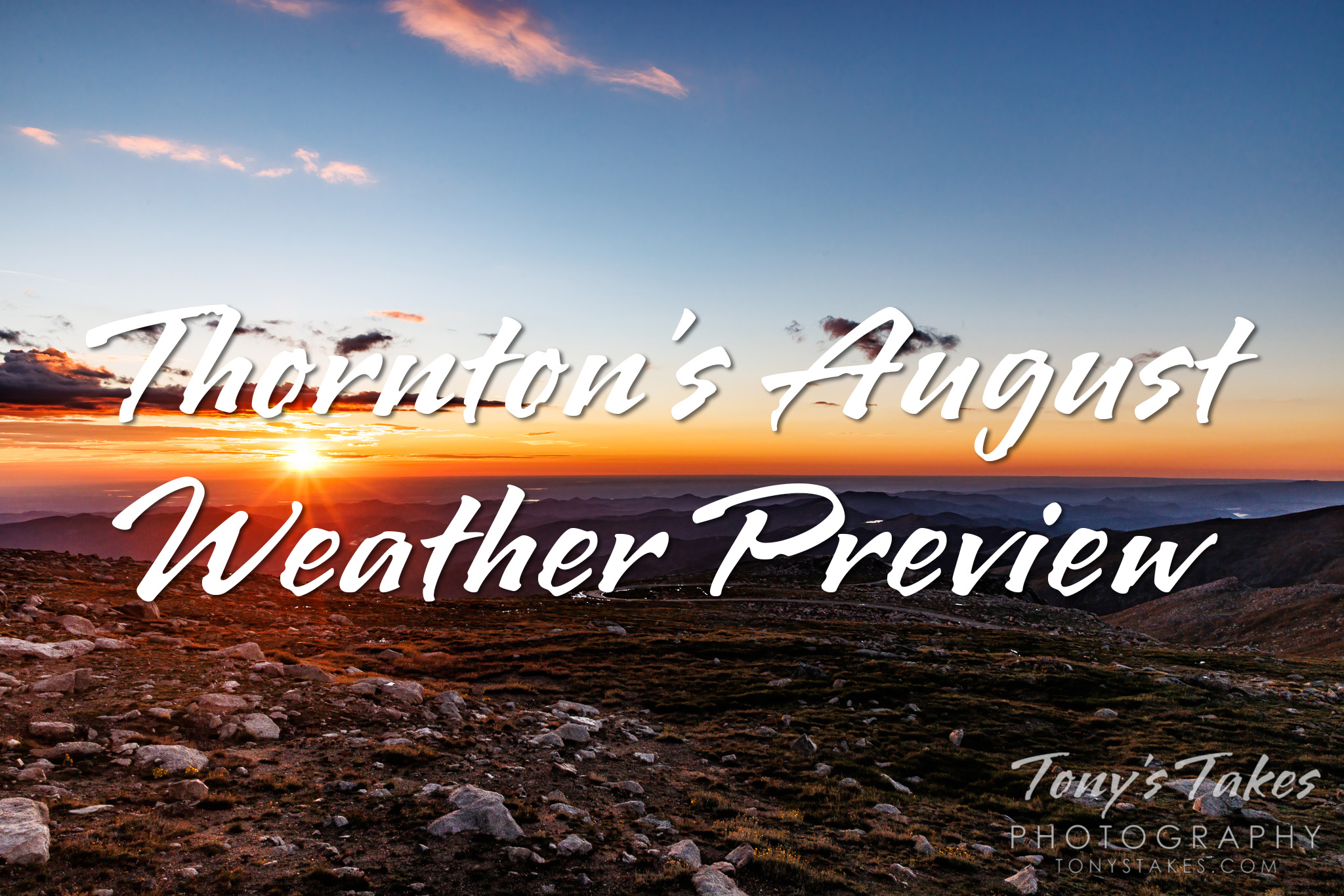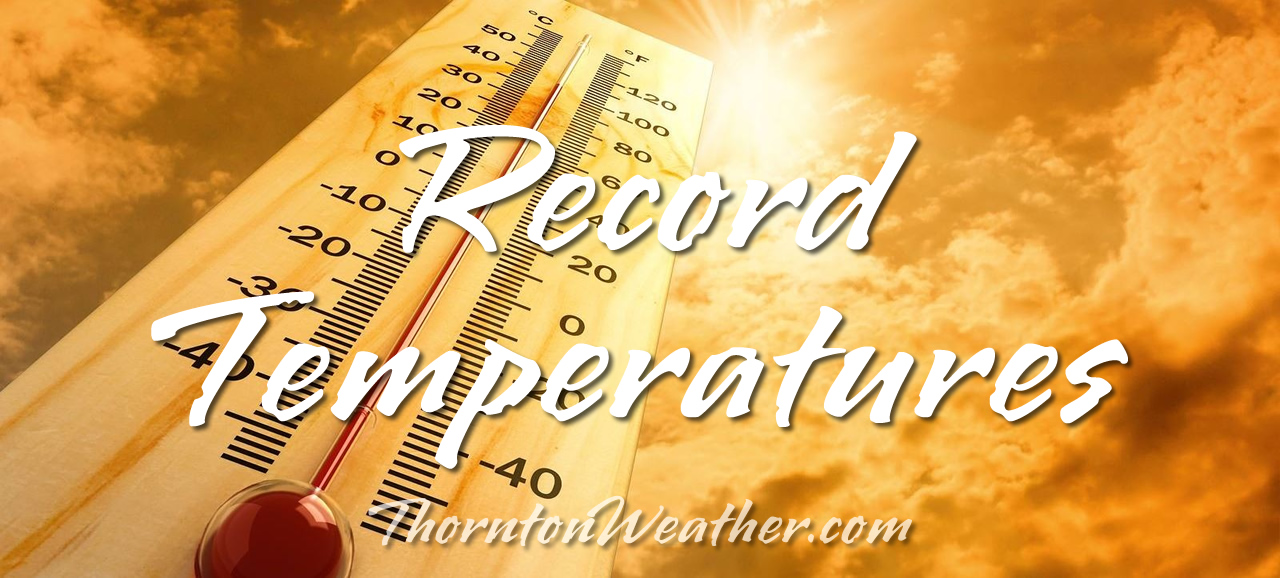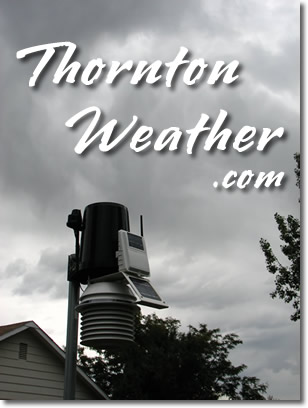
Monsoonal moisture oftentimes streams into Colorado this time of year leading heavy rain and dangerous lightning. Our look back at this week in Denver weather history features many flooding events caused by the moisture and even some tornadoes.
From the National Weather Service:
13-5
In 2008…a streak of 24 consecutive days of 90 degrees shattered the previous record of 18 consecutive days established in 1901 and 1874. Ironically…no new single day record high temperatures were set in the month of July. In August however…a record of 104 degrees was set on the 1st…and another record of 103 degrees was set on the 2nd. In addition…a record low min of 70 degrees was set on August 2nd.
18-2
In 1987…a streak of 16 consecutive days of 90 degrees ranked 4th on the list of hot streaks. The record of 24 consecutive days was established in the summer of 2008.
27-31
In 1956…96 percent of the total precipitation for the month of July occurred over the last five days of the month. Heavy thunderstorms produced 4.00 inches of rainfall at Stapleton Airport. This amount of precipitation in 5 days or less had been exceeded only 3 times in previous record. The last time had been in December of 1913 as snow. Considerable property damage occurred across metro Denver from flooding.
28
In 1882…intense thunderstorm lightning struck a number of places in the city…but no significant damage was reported.
In 1910…heavy thunderstorm rainfall totaled 2.21 inches in downtown Denver. Rainfall was 1.11 inches in an hour during the early afternoon.
In 1922…heavy rainfall to the south of Denver caused Cherry Creek to rise to the top of the retaining walls in the city. The creek did not flood; however…the large volume of water discharged into the South Platte River did inundate a few blocks of Globeville. Flooding also occurred along bayou creek near Franktown to the south of the city.
In 1923…thunderstorm winds were sustained to 38 mph with gusts to 52 mph.
In 1957…iridescent cirrocumulus clouds of unusual formation and brilliant color…oriented from southwest to northeast over metro Denver…were sighted by U.S. Weather Bureau observers at Stapleton Airport shortly after noon.
In 1966…heavy rains from a severe thunderstorm caused flash flooding on Deer Creek…southwest of Littleton. A child was injured when washed from a car caught in the flood waters. The flooding damaged property along the creek. Strong winds damaged several houses in suburban Littleton.
In 1970…a microburst wind gust to 52 mph was recorded at Stapleton International Airport.
In 1974…a tornado was sighted just east of Buckley Field in Aurora. No damage was reported.
In 1982…up to 2.50 inches of rain drenched an area just southwest of Denver in 30 minutes. This was the second day of heavy rain across portions of metro Denver.
In 1984…1.25 inches of rain fell in 45 minutes in Arvada. Minor flooding occurred on bear creek after a small dam broke.
In 1989…lightning killed two men in Arvada. They were taking wash from a clothesline when a bolt hit the older man…39… Killing him instantly. The bolt then traveled along the line…which was stretched between 2 tall trees…and hit his 26-year-old brother who died the next day.
In 1996…several weak tornadoes developed along a thunderstorm outflow boundary that moved into southern weld…northern Jefferson…and Adams counties. The tornadoes sighted near Bennett…Barr Lake…and in Arvada caused little damage. Strong thunderstorm winds downed several trees in the city of Denver and toppled several trees 7 miles west of Arvada where shingles were blown off several houses. Thunderstorm wind gusts reached 58 mph in Broomfield.
In 1997…a weak tornado touched down briefly in Parker… Damaging a greenhouse. Twenty pieces of the fiberglass roof were ripped away. Heavy rainfall in the foothills washed out some culverts in the Pine and Conifer areas. Heavy rainfall spread over the plains with 4 to 7 inches reportedly falling near Hudson. Several county roads were washed out between Fort Lupton and Hudson. Several basements in the area were flooded up to the ceiling. Standing water…up to 3 feet deep…was reported in some backyards. Later in the evening…a flash flood killed 5 people and injured 40 others in two mobile home parks in Fort Collins. The torrential rainfall also caused extensive damage on the Colorado state university campus. Thunderstorm rainfall totaled 0.80 inch at Denver International Airport and 1.09 inches at the site of the former Stapleton International Airport.
In 1999…heavy rainfall…up to 3 inches an hour…triggered a massive rock and mudslide along I-70 near Bakerville. The slide area was about 200 feet wide and 20 feet deep. Several other smaller slides were also reported along the highway. As a result…I-70 was closed for nearly 25 hours in both directions until the debris could be cleared from the roadway. The blockage of I-70 was one of the longest in the history of the highway in Colorado. A severe thunderstorm produced a wind gust to 64 mph at Denver International Airport. The storm also produced 1.56 inches of rain and briefly reduced the visibility to 1/4 mile.
In 2004…a severe thunderstorm produced hail as large as 1 inch in diameter in Thornton.
In 2010…a wet microburst produced very heavy rain and torrential hail in Boulder County…in the vicinities of caribou…Nederland and Eldora. Flash flooding washed out sections of County roads 126 and 128 near caribou. Several large Boulders had fallen across the roadways. Considerable flooding was reported in Nederland. Water was also observed running across County Road 130…between Eldora and Nederland. The hail had accumulated up to 8 inches deep near Eldora. Several vehicles were stuck in the ice…forcing the temporary closure of CR130 and the Lake Eldora Ski Road until snowplows could clear away the hail. Lightning strikes caused minor damage to two local businesses in Nederland. At Denver International Airport…a thunderstorm produced 0.30 inches of rain along with a peak wind gust to 38 mph.
In 2012…a tornado touched down briefly at the southeast corner of Mt. Evans near Lincoln Lake. The estimated elevation where this tornado touched down was near 12500 feet. This would make this tornado one of the highest ever observed in the U.S.
In 2014…two weak landspouts touched down; one near Ft. Lupton and the other on the southwest side of the Rocky Mountain Arsenal Wildlife Refuge. No damage was reported. A strong thunderstorm wind capsized a boat in Barr Lake. All three occupants made it to shore with no injuries.
In 2016…severe thunderstorms in western Adams and east central Jefferson Counties produced large hail near Lakewood…Golden and South Glenn. The hail ranged from 1 to 1 1/2 inches in diameter.
28-30
In 1889…dense smoke from forest fires in the mountains obscured the sun over the city for three days.
In 1971…a vigorous cold front late on the 28th produced northeast wind gusts to 39 mph and record breaking cold temperatures on the 29th and 30th. The temperature dipped to 47 degrees on the 29th and 43 degrees on the 30th… Setting record minimums for the dates. Upslope cloudiness along with rain and fog early on the 29th helped set a record low maximum temperature of 58 degrees for the date.
29
In 1878…a total eclipse of the sun was observed at 2:20 pm. From before to during the eclipse…the temperature in the sun fell from 114 degrees to 82 degrees…while the shade temperature fell from 89 degrees to 83 degrees.
In 1880…heavy thunderstorm rain and hail flooded streets and ditches.
In 25 minutes…0.76 inch of rain fell on the city along with large hail to 3/4 inch in diameter. There were no strong winds with the storm.
In 1890…a thunderstorm produced sustained west winds to 48 mph with gusts to 60 mph…but only 0.01 inch of rain.
In 1956…heavy rain and hail fell over west and north Denver.
In 1964…hail to 3/4 inch in diameter fell at Lowry Airfield.
In 1978…a small tornado was sighted just east of Parker. No damage was reported.
In 1989…heavy rain drenched all areas of the Front Range… Both in the foothills and adjacent plains. Amounts of 1 to 3 inches were general over the area. Damage was confined to a few minor road washouts and some street…basement…and crop flooding. Thunderstorm rainfall totaled 1.44 inches at Stapleton International Airport where north winds gusted to 43 mph. Lightning struck a 250 thousand dollar home near Nederland and started a fire which destroyed all of it except two garages. Lightning started a fire in a home in Evergreen. It reached the house by hitting a tree…then traveling through a metal clothesline strung between the tree and the building.
In 1995…thunderstorm winds gusted to 59 mph in Brighton. Thunderstorm winds from the south-southeast gusted to 41 mph at Denver International Airport. High temperature of 99 degrees was a new record maximum for the date in Denver.
In 1997…heavy rain caused flooding in an apartment building in Westminster. Several residents had to be evacuated from their apartments. A woman in Aspen Park received minor injuries…when lightning passed through an office window and struck her. She suffered temporary blindness for about 15 minutes.
In 2003…hail as large as 1 inch in diameter pelted Conifer… Highlands Ranch…and Franktown.
29-30
In 1997…heavy rain caused flooding and flash flooding in central portions of Adams and Arapahoe counties. Two homes were extensively damaged when water flooded the basements and adjacent pasture area in Strasburg. Water 4 to 5 feet deep had pooled in the lower lying areas of the town. A portion of quincy road was closed in Arapahoe County when 4 feet of water covered the roadway. Rainfall totaled 3.06 inches at Denver International Airport…establishing a new record for 24-hour rainfall in July. The previous record was 2.42 inches set in 1965 on the 24th and 25th.
Continue reading July 28 to August 3: This Week in Denver Weather History →

















































